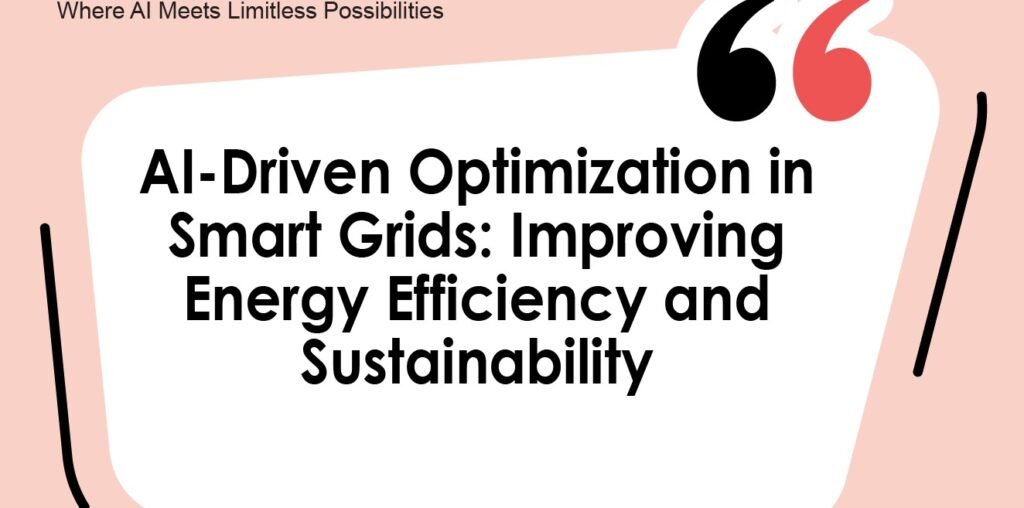As the global demand for energy surges and the imperative to combat climate change intensifies, optimizing energy systems for efficiency and sustainability has become crucial. Smart grids, which integrate advanced communication and control technologies into traditional electrical grids, are pivotal in addressing these challenges. Artificial intelligence (AI) is at the forefront of enhancing smart grids, offering sophisticated tools for optimization that promise significant improvements in energy efficiency and sustainability. This article explores how AI-driven optimization is transforming smart grids and the benefits it brings to the energy sector.
The Role of AI in Smart Grid Optimization
- Real-Time Energy Management: AI enhances smart grids by providing real-time energy management capabilities. Machine learning algorithms analyze data from various sources, including smart meters, sensors, and weather forecasts, to predict energy demand and supply fluctuations. By processing this data, AI can adjust the distribution of energy dynamically, ensuring that supply matches demand and reducing the likelihood of outages or inefficiencies.
- Predictive Maintenance: AI-driven predictive maintenance helps in monitoring the health of grid infrastructure, such as transformers, substations, and power lines. By analyzing historical data and real-time sensor inputs, AI algorithms can predict potential equipment failures before they occur. This proactive approach reduces downtime, minimizes repair costs, and extends the lifespan of critical infrastructure, contributing to a more reliable and efficient grid.
- Demand Response and Load Management: AI facilitates advanced demand response and load management strategies. By analyzing usage patterns and predicting peak demand periods, AI systems can automate load adjustments and encourage consumers to shift their energy usage to off-peak times. This balancing act reduces the strain on the grid during peak periods, enhances overall efficiency, and supports the integration of renewable energy sources.
- Integration of Renewable Energy: The integration of renewable energy sources, such as wind and solar, poses challenges due to their variability. AI helps in optimizing the use of these intermittent resources by forecasting their availability and adjusting grid operations accordingly. AI algorithms can also manage energy storage systems, ensuring that excess renewable energy is stored when available and dispatched when needed, thus smoothing out fluctuations and enhancing grid stability.
- Energy Efficiency Optimization: AI-driven optimization improves the overall energy efficiency of the grid by identifying and mitigating losses. Algorithms analyze data from various grid components to detect inefficiencies and suggest corrective actions. This includes optimizing the operation of generators, adjusting voltage levels, and minimizing energy losses through transmission and distribution.
- Consumer Engagement and Energy Management: AI tools empower consumers with smart energy management solutions. Through AI-powered applications and platforms, consumers can monitor their energy usage, receive personalized recommendations for reducing consumption, and participate in demand response programs. This increased engagement helps in managing energy use more effectively and supports broader grid efficiency.
Benefits of AI-Driven Optimization in Smart Grids
- Enhanced Efficiency: AI-driven optimization significantly enhances the efficiency of energy production, distribution, and consumption. By predicting demand, optimizing load management, and reducing losses, AI helps in making the grid more efficient and reliable, ultimately lowering energy costs and resource consumption.
- Increased Reliability and Resilience: AI improves the reliability and resilience of smart grids by enabling real-time monitoring and predictive maintenance. This reduces the likelihood of outages, enhances response to emergencies, and ensures continuous service, even in the face of disruptions or equipment failures.
- Support for Sustainable Energy Integration: AI supports the integration of renewable energy sources by managing their variability and optimizing their use. This fosters a transition to more sustainable energy systems, reduces reliance on fossil fuels, and contributes to lower greenhouse gas emissions.
- Cost Savings: The efficiency gains achieved through AI optimization lead to significant cost savings for both utilities and consumers. Reduced energy losses, lower maintenance costs, and optimized operations translate into financial benefits, making energy systems more cost-effective and affordable.
- Enhanced Consumer Experience: AI-driven tools and applications improve the consumer experience by providing insights into energy usage, offering personalized recommendations, and enabling participation in demand response programs. This empowers consumers to make informed decisions and manage their energy consumption more effectively.
Challenges and Considerations
- Data Privacy and Security: The integration of AI in smart grids involves handling vast amounts of data, raising concerns about data privacy and security. Ensuring robust data protection measures and compliance with privacy regulations is essential for safeguarding sensitive information and maintaining public trust.
- Integration with Legacy Systems: Incorporating AI into existing grid infrastructure and legacy systems can be challenging. Ensuring seamless integration and interoperability requires careful planning, investment in technology, and upgrades to existing infrastructure.
- Algorithm Transparency and Accountability: AI algorithms can be complex and opaque, making it difficult to understand how decisions are made. Enhancing the transparency and explain ability of AI systems is important for ensuring accountability and trust in grid operations.
- Infrastructure and Investment: Implementing AI-driven optimization requires significant investment in technology and infrastructure. Utilities and stakeholders must allocate resources for developing and deploying AI solutions, as well as for training personnel and maintaining systems.
Conclusion
AI-driven optimization is revolutionizing smart grids by enhancing efficiency, reliability, and sustainability. Through real-time energy management, predictive maintenance, demand response, and support for renewable energy integration, AI is transforming the way energy systems operate and respond to changing demands. While challenges exist, the benefits of AI in smart grids are substantial, offering improved performance, cost savings, and a more sustainable energy future. As technology continues to advance, AI will play an increasingly pivotal role in shaping the energy landscape, driving progress towards smarter, more resilient, and environmentally friendly energy systems.

